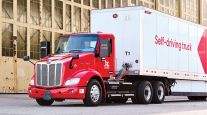Senior Reporter
Tech Startups Cite Progress on Path to Self-Driving Trucks
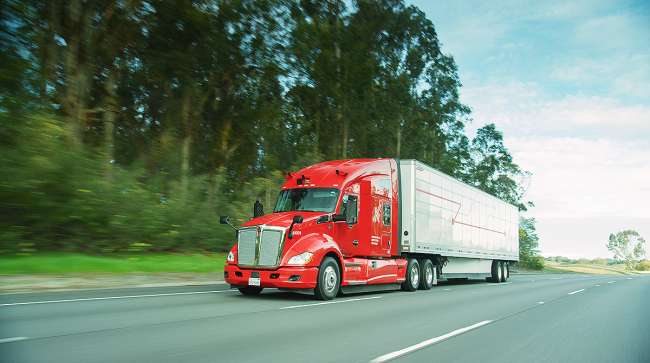
[Stay on top of transportation news: Get TTNews in your inbox.]
Over the past year, startups working to commercialize highly automated heavy-duty trucks competed for more capital and engineers, and each pushed deeper into systems development.
Companies such as Embark, Ike, Kodiak Robotics, Starsky Robotics and TuSimple evaluated their progress with computer simulations and runs on test tracks and along stretches of public roads. Some even hauled freight.
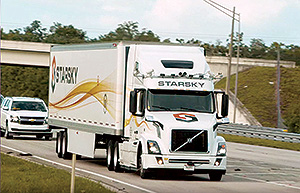
Starsky Robotics tests an unmanned truck on a 9.4-mile stretch of Florida's Turnpike in Orlando. (Starsky Robotics via YouTube)
For the most part, these developers aim to enable what SAE International has defined as Level 4 automated driving, in which the truck can drive itself under certain conditions without any driver input or backup assistance.
But more needs to be done with hardware, software and business models before self-driving longhaul trucks can reliably join the flow of everyday commerce.
Meanwhile, developers’ efforts gained force in October 2018 when the U.S. Department of Transportation issued the latest iteration of its guidelines for automated vehicles.
That document, titled “Preparing for the Future of Transportation: Automated Vehicles 3.0,” goes into detail on issues specific to automated commercial trucks, and how they would be deployed under existing regulations.
The document clarifies that human-specific federal motor carrier safety regulations such as driver hours-of-service limits would not apply to vehicles that do not require a human operator. It also states that moving forward, the Federal Motor Carrier Safety Administration’s regulations will no longer assume that a commercial truck driver is always a human or that a human is necessarily onboard during its operation.
“[That] was a huge shift in the autonomous trucking space,” said Robert Brown, director of government affairs at self-driving truck developer TuSimple. “Prior to that, if you’d talked to me I would have been quite nervous about where we stood from a regulatory perspective because trucks were not included in [DOT’s] AV 2.0.”
The 3.0 document provided a clear path for commercial deployment of highly autonomous trucks, Brown said. “It’s been a huge boon for the industry from a regulatory perspective.”
Embark CEO and co-founder Alex Rodrigues agreed. “We feel it was a really big step forward for the industry.”
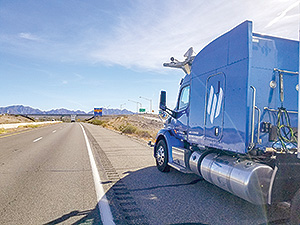
A tractor equipped with Embark's self-driving system sits on the shoulder of Interstate 10, where the company has been using its truck to haul freight. (Embark)
To begin the next step in the federal regulatory process, FMCSA and the National Highway Traffic Safety Administration published advance notices of proposed rulemaking, seeking comments on ways to remove regulatory barriers for automated driving systems. The comment period closed this summer.
Tech startups are not alone in the quest to make highly automated commercial vehicles a reality; truck manufacturers also are investing in the technology.
Daimler Trucks, which manufactures Freightliner and Western Star trucks in North America, acquired a majority stake in self-driving vehicle pioneer Torc Robotics this year to bolster its pursuit of highly automated trucks. The companies have begun testing the technology on highways in southwest Virginia.
Earlier this year, Martin Daum, head of Daimler’s global truck and bus division, outlined the company’s goal of introducing Level 4 automated driving within 10 years.
“Level 4 will open up the door for many interesting use cases, including areas like airfields, harbors and agriculture. And, most importantly, we see use cases on public roads — which for the foreseeable future means hub-to-hub transport on highways,” a DTNA spokesman told Transport Topics.
Volvo Trucks, meanwhile, has showcased its Vera concept, an unmanned tractor designed to operate over short distances at low speeds in industrial areas.
An Expanding Field
Some self-driving truck startups have been operating for several years, while others have appeared within the past year or two.
Ike entered the space in August 2018, and is OK with being perceived by some as moving slowly, even though the company isn’t, said CEO and co-founder Alden Woodrow.
Ike is focused on a long-term goal — a commercial product that operates at scale, with hundreds of automated trucks driving safely and reliably on the highway.
“There is a lot of noise in the space because of the competition for talent, capital and other things,” Woodrow said. “There are lots of companies wanting to tell their stories. We are sort of OK with flying under the radar a little bit more and not trying to make that noise because we have confidence in our team and strategy.”
Ike licensed technology last year from a company called Nuro, which develops autonomous delivery vehicles. Ike got a copy of everything Nuro had built over the previous two years and began applying it to trucks.
“It was a really strong foundation and gave us the ability to start working on the harder problems, and we have been working on some of those harder problems,” Woodrow said.
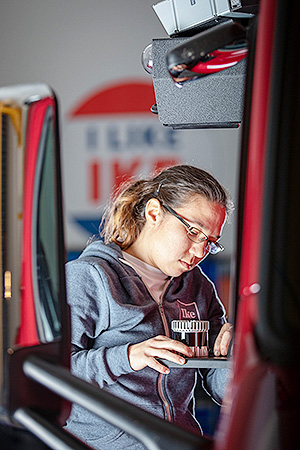
A worker at Ike installs a lidar sensor on a test truck. The company is testing self-driving prototypes in the San Francisco Bay area. (Ike)
Ike is testing, with humans onboard, self-driving prototypes in the San Francisco Bay Area equipped with different components.
The company ultimately wants its automated trucks to operate on the highway without a driver. In fact, Woodrow argued that keeping the human out of a self-driving truck simplifies things.
The issue is the handoff of control to humans onboard, through the human-machine interface, Woodrow said. “It may even be a harder problem than having the truck drive on its own.”
Kodiak Robotics, another self-driving truck startup, came along in April 2018.
“There is a long list of high-level things that need to be done. Luckily, I think we are off to a great start,” said Paz Eshel, Kodiak’s chief operating officer and co-founder.
Those challenges include developing reliable, safety-critical hardware and determining how the system should interpret its surroundings and perceive the world around it, he said. “What are the objects you care about? What are objects you don’t care about?”
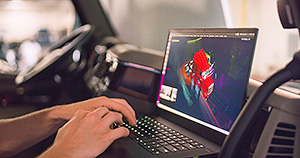
An engineer checks a simulation on a laptop inside the cab of a test vehicle. (Ike)
Kodiak is taking an approach more akin to traditional, functional, safety-driven engineering such as in the aerospace, aviation and automotive industries, rather than “slapping a lot of sensors on a truck and sending it out into the real world,” Eshel said.
In August, Kodiak announced it started making its first commercial deliveries with a safety driver behind the wheel.
Eshel believes within five years the technology will be commercially available. “Whether or not that means it is being sold from a truck factory or being operated as a service that is provided to trucking companies, I think that still remains to be seen,” he said. “There is a lot of work behind the scenes on that specific aspect of the problem. But the technology itself will be ready within the next several years.”
Embark is 3 years old, but that makes it one of the more established players in the emerging field.
CEO Rodrigues said one of the company’s major milestones was achieving city-to-city driving with no disengagements.
The company has reached a point where its trucks are able to drive an entire route, city to city, without human intervention, he said.
For now, Embark’s automated trucks have a driver behind the wheel, but the company sees a time when certain routes will not require one.
The focus now is on building reliability, Rodrigues said. “This is no longer a science project as it is somewhat on the car side. It’s now about reliability and systems engineering.”
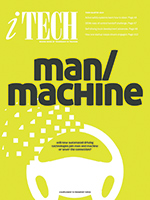
Read more iTECH stories:
Rodrigues’ background is in competitive robotics as opposed “to big companies or academia,” he said.
“[In competitive robotics,] you learn a great deal about building systems efficiently and on short time scales,” he said. “I think you have seen that come into play [with Embark] fairly dramatically.”
Of late, Embark has started moving freight for multiple new Fortune 500 companies and has increased its fleet to 13 trucks, he said.
Meanwhile, Stefan Seltz-Axmacher, CEO and co-founder of Starsky Robotics, presented a contrarian point of view — insisting that much of the work that is essential for the deployment of automated vehicles has been done, including the emergence of regulatory environments for testing.
“Anyone who says that there aren’t unmanned autonomous vehicles because of regulation is either not smart or lying,” he said in an email response. “In fact, it has been legal to operate unmanned vehicles in multiple states for over five years. The entire problem, that many companies refuse to admit, is that their technology hasn’t been ready.”
Starsky is developing a system that operates trucks autonomously on the highway and enables them to be remote-controlled, or tele-operated, by human drivers in offices for the first and last mile, from highway exit to distribution center.
In June, Starsky completed what it hailed as the first test on a public highway with no human onboard.
“We drove a heavy-duty commercial truck for 9.4 miles along Florida’s Turnpike with no one in it: successfully navigating a rest area, merging onto the highway, changing lanes and maintaining a speed of 55 mph,” Seltz-Axmacher said.
In addition to developing self-driving technology, the technology developer has been operating a traditional trucking business for a couple of years that has generated revenue, led to key partnerships, “and, importantly, helped build a company that works in the real world,” he said.
Industry Partnerships
Self-driving truck startups also have continued to form partnerships with high-profile carriers and shippers.
UPS Ventures, the venture capital arm of parcel giant UPS Inc., purchased a minority stake in TuSimple on Aug. 13.
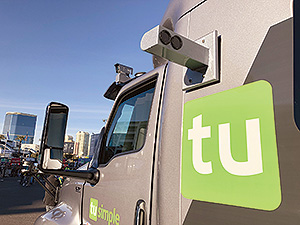
TuSimple showcases one of its self-driving trucks at CES in Las Vegas. TuSimple says its camera-based system gives its trucks forward visibililty up to 1,000 meters. (Seth Clevenger/Transport Topics)
UPS said it is working with TuSimple to test self-driving tractor-trailers on a route in Arizona to determine if the trucks can enhance service and efficiency in its network.
UPS ranks No. 1 on the Transport Topics Top 100 list of the largest for-hire carriers in North America.
Although TuSimple’s self-driving trucks have two people onboard today, the company is working to reach the point where driver oversight is no longer necessary.
TuSimple also conducted a two-week pilot this summer with the U.S. Postal Service, hauling mail and packages on five round trips between Dallas and Phoenix.
“It was a great route — difficult, complicated, across three states,” Brown said. “The fact that they are interested in and supportive of this type of technology is huge. There is a lot of skepticism and misunderstanding about this technology. We are hopeful we can work with them in the future.”
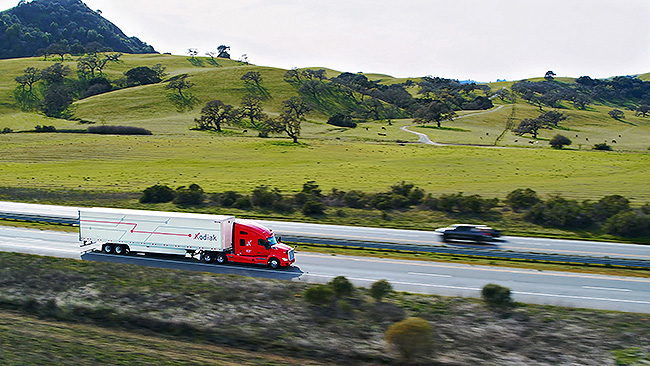
A self-driving truck prototype operated by Kodiak Robotics travels on a highway. (Kodiak Robotics)
TuSimple credited new camera technology with helping to pave the way for that partnership.
“We worked with a new camera that allows us to do night vision, which is a big breakthrough from a business and technology perspective. The whole idea of autonomous vehicles is they can run 24 hours a day,” Brown said.
The ultimate timeline for the implementation of highly automated trucks remains elusive.
Greg Hirsch, senior vice president at flatbed carrier Daseke Inc., said the development of government regulations and addressing safety issues that come with autonomous vehicles likely are the biggest hurdles to commercialization.
Other issues that must be addressed include the regulation of weigh stations and equipping distribution centers to be able to receive fully autonomous vehicles, he added.
Widespread adoption of autonomous trucking technology may not occur for a decade or more, Hirsch noted.
WANT MORE NEWS? Listen to today's Daily Briefing
“But all transportation sectors are not created equal,” he said. “Daseke’s flatbed specialized trucking solutions are used to ship unusually large and often extremely challenging cargo, where a highly skilled driver is critical for day-to-day operations. Therefore, we predict the Level 4 vehicle adoption timeline to be even longer for our more specialized sector.”
Daseke ranks No. 21 on the Transport Topics Top 100 list of the largest for-hire carriers in North America.


